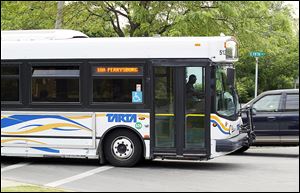
EDITORIAL
Road map
TMACOG’s new long-range transportation plan offers region another chance to move forward on transit
3/23/2014
The transit debate should be about how TARTA buses such as this one can service other places in northwest Ohio.
When the Toledo Metropolitan Area Council of Governments (TMACOG) last updated its regional transportation plan four years ago, improving northwest Ohio’s interstate highway system dominated the debate. Today, people understand that Toledo’s growth as a region and its ability to compete with other urban areas demand better mass transit as well.
The kinds of roads northwest Ohio residents will drive on and the transit services they will use through 2045 will depend largely on the priorities set by the 30-year transportation plan.
TMACOG won’t submit an approved plan to the federal government until July, 2015. But it seeks public input now, so that the transportation map will reflect the needs of Lucas, Wood, and southern Monroe counties, Diane Reamer-Evans of TMACOG told The Blade’s editorial page.
Public meetings run through April 3. Resident may also complete surveys at public libraries or online at tmacog.org.
So far, improving mass transit has ranked high among the transportation needs cited by residents. And it should.
Metropolitan Toledo ranks among the worst U.S. metro areas for having jobs in neighborhoods served by public transit. In suburban Toledo, only one-third of jobs are accessible to transit users, depriving many businesses of potential workers.
Nearly 14 percent of Toledo households — disproportionately poor and African-American — don’t have vehicles, according to Census figures. More and more young professional urbanites, a group that drives economic development, want reliable and convenient transit options.
Nationwide, people are driving less, as aging Baby Boomers spend more time away from their vehicles, and young people choose public transportation, which shows record ridership.
Despite Perrysburg’s shortsighted exit from the regional transit system in 2012, Toledo Area Transit Authority ridership continued to rise last year, with nearly 3.5 million passenger boardings. Nationwide, transit ridership reached a level not seen since the mid-1950s.
Still, Toledo is moving backward. Following Perrysburg, Spencer Township moved to leave TARTA last year. TMACOG failed to take a position on those withdrawals — a sad commentary on the state of local transit leadership.
Economies are regional, and northwest Ohio communities will rise or fall together. The transit debate here should be about how TARTA can expand into places such as Oregon and Springfield Township; how Toledo can move from a fragmented local property tax to a more uniform and sustainable regional sales tax, and how the region can create a better, more-reliable basic bus system.
TMACOG’s new 30-year plan, “On the Move 2015-2045,” should recommend better ways to pay for a regional transit system that covers all of Lucas County. It should call for studying whether certain heavily traveled transit corridors could support rapid transit bus service or even light rail. Grand Rapids, Mich., a smaller city than Toledo, has done that, using federal dollars that could be earmarked for northwest Ohio.
Transit and transit-oriented development mean a stronger regional economy. They reduce road congestion and wear, get people to jobs, improve air quality, and conserve energy.
Five years ago, TMACOG met with local stakeholders and officials and tried, unsuccessfully, to forge a consensus on mass transit. Its new transportation road map provides another opportunity to get it right.